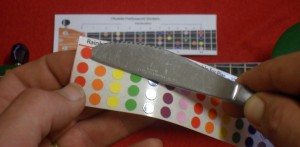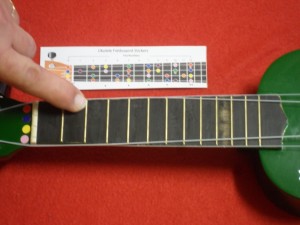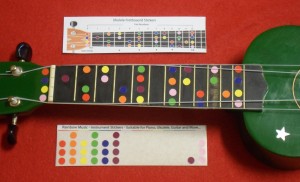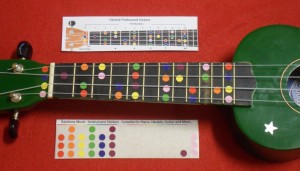Ukulele Stickers – How to apply and use
 |
Ukulele StickersFirst things first, why would you want to put colored note Ukulele Stickers on the Fretboard of your Ukulele?
|
So what’s so special about these Ukulele Stickers?
The fretboard of the Ukulele is a hostile environment, with vibration and pressure causing many stickers to wear and tear. The Ukulele Stickers by Rainbow Music are different. They are plasticized to maintain color which also makes them hard wearing.
Using stickers to highlight where all your notes are, will dramatically accelerate your ability to learn and play many chords, chord shapes and give you the freedom to explore Scales and Riff patterns with ease.
We like to think of the Ukulele Stickers as training wheels, a tool to help you get your balance and confidence, but not something to be relied on indefinitely, so they should be made to stick for as long as you want to keep them on and be able to be removed without causing damage to your fretboard, when you’re ready to make the leap.
How will the Ukulele Stickers help me learn to play?
Great question right, because it should be about how they improve and accelerate our ability to learn, play and explore the Ukulele. To answer this it’s best to start with what they are not!
These Ukulele Stickers don’t use a single color for a Chord as other stickers do, because knowing which notes make up each chord is far too important. By knowing which notes make up the chord you will be able to know where you are and where you can lead off from when you go free-styling.
The Ukulele Stickers do not include the Flat and Sharp notes as this is too overwhelming to the eye. Let’s say you want to find a C#, soon you will know that C is yellow, so all you need to do is to move up one step (a single semi-tone) from the C and you’ll have the C#.
Why have we used these colors for the Ukulele Stickers?
You are right, there are other color systems in use with the most common being the color system based on Isaac Newton’s work. The thing here is that when Isaac Newton said “the colors of the Rainbow are like the Keys on the Piano” he was absolutely right! The problem started after this with the Major Scale Music Theory. In the Major Scale Music Theory everything is centered on Middle C, so others in their infinite wisdom took the first note in Music Theory “C” and started with the first color of the Rainbow “Red”. Unfortunately this might be metaphorically accurate but it’s NOT accurate in science or nature. The first color of the Rainbow is Red and the first note in Music is “A”
We have written specifically to exactly how the Colors of the Rainbow and Music Notes link together in nature and you can see for yourself here: Connecting Musical Notes to Color
The colors used by Rainbow Music are an accurate reflection of nature, where the harmonic of the note “A” is in fact the color “Red” and so on with the remaining whole notes. OK some may say BIG DEAL and you know, it is! By using the correct colors we can properly re-connect to the natural world, take our lead from nature and compose and play accurately based on what we see: See Green Grass, then we should play in D.
Once our eyes are opened, the full truth can be revealed. We shouldn’t teach our children something that is untrue and we MUST give them the truest reflection of nature, so all of our sciences, math, geometry, astronomy, fashion and design can be reflected accurately. Pretty heavy yeah!
How do I apply the Ukulele Stickers to my Fretboard Inlay?
How else do the Ukulele Stickers connect with other Rainbow Music Resources?
We suggest you start here with Musical Memory, it’s a simple and easy way to learn the color system and the Musical Alphabet all at the same time: https://www.rainbowmusic.com.au/music-notes/
Then possibly try this a simple but beautiful song, for finger picking:
Now move onto the Ukulele Wheel where you can explore chord shapes and learn about key:
And finally the tool to let you explore any chord, chord shape or Scale pattern.











